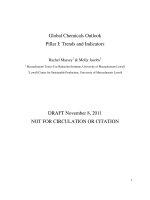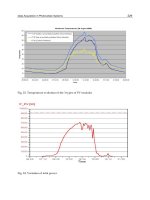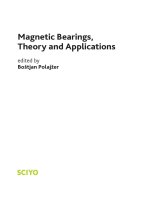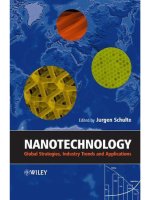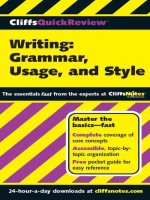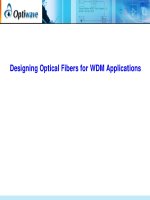Nanotechnology Global Strategies, Industry Trends and Applications phần 1 potx
Bạn đang xem bản rút gọn của tài liệu. Xem và tải ngay bản đầy đủ của tài liệu tại đây (2.76 MB, 20 trang )
Nanotechnology
Global Strategies, Industry Trends and Applications
Edited by
Jurgen Schulte
Asia Pacific Nanotechnology Forum
Nanotechnology
Nanotechnology
Global Strategies, Industry Trends and Applications
Edited by
Jurgen Schulte
Asia Pacific Nanotechnology Forum
Copyright # 2005 John Wiley & Sons Ltd, The Atrium, Southern Gate, Chichester,
West Sussex PO19 8SQ, England
Telephone (+44) 1243 779777
Email (for orders and customer service enquiries):
Visit our Home Page on www.wiley.com
All Rights Reserved. No part of this publication may be reproduced, stored in a retrieval system or
transmitted in any form or by any means, electronic, mechanical, photocopying, recording, scanning or
otherwise, except under the terms of the Copyright, Designs and Patents Act 1988 or under the terms
of a licence issued by the Copyright Licensing Agency Ltd, 90 Tottenham Court Road, London
W1T 4LP, UK, without the permission in writing of the Publisher. Requests to the Publisher should be
addressed to the Permissions Department, John Wiley & Sons Ltd, The Atrium, Southern Gate,
Chichester, West Sussex PO19 8SQ, England, or emailed to , or faxed to
(+44) 1243 770620.
This publication is designed to provide accurate and authoritative information in regard to the subject
matter covered. It is sold on the understanding that the Publisher is not engaged in rendering
professional services. If professional advice or other expert assistance is required, the services of a
competent professional should be sought.
Other Wiley Editorial Offices
John Wiley & Sons Inc., 111 River Street, Hoboken, NJ 07030, USA
Jossey-Bass, 989 Market Street, San Francisco, CA 94103-1741, USA
Wiley-VCH Verlag GmbH, Boschstr. 12, D-69469 Weinheim, Germany
John Wiley & Sons Australia Ltd, 33 Park Road, Milton, Queensland 4064, Australia
John Wiley & Sons (Asia) Pte Ltd, 2 Clementi Loop # 02-01, Jin Xing Distripark, Singapore 129809
John Wiley & Sons Canada Ltd, 22 Worcester Road, Etobicoke, Ontario, Canada M9W 1L1
Wiley also publishes its books in a variety of electronic formats. Some content that appears in
print may not be available in electronic books.
Library of Congress Cataloging-in-Publication Data
Nanotechnology: global strategies, industry trends & applications/edited by Jurgen Schulte.
p. cm.
Includes bibliographical references and index.
ISBN 0-470-85400-6 (cloth : alk. paper)
1. Nanotechnology. I. Schulte, Jurgen.
T174.7.N3738 2005
620
0
.5–dc22
2004023729
British Library Cataloguing in Publication Data
A catalogue record for this book is available from the British Library
ISBN 0-470-85400-6 (HB)
Typeset in 10/12pt Times Roman by Thomson Press (India) Limited, New Delhi
Printed and bound in Great Britain by TJ International, Padstow, Cornwall
This book is printed on acid-free paper responsibly manufactured from sustainable forestry
in which at least two trees are planted for each one used for paper production.
Contents
List of Contributors xi
Foreword xiii
Hiroyuki Yoshikawa
Introduction: Movements in Nanotechnology 1
Jurgen Schulte
Part One: National Nanotechnology Initiatives
in Asia, Europe and the US 5
1 Scientific Development and Industrial Application
of Nanotechnology in China 7
Hongchen Gu and Jurgen Schulte
1.1 Policy and Objective of Nanotechnology Development in China 7
1.1.1 General Strategy 8
1.1.2 Research Objectives with in the Tenth Five-Year Plan 8
1.2 Application of Nanotechnology 9
1.2.1 Materials Processing 9
1.2.2 Nanochip Fabrication and Integration 9
1.2.3 Nanochip Processing Methods 9
1.3 Analysis and Characterization of Structure and Function 9
1.3.1 National Safety 9
1.3.2 Technology Transfer and Applications of Nanomaterials
and Nanochips 10
1.3.3 Building Ba sic Nanotechnology Centres and an R&D Base 11
1.4 Main Policy and Measures 11
1.4.1 Enhance Leadership and Coordination
of Nanotechnology R&D 11
1.4.2 Implementation of National Nanotechnology Initiatives 12
1.4.3 Encourage All Participants and Create Environmentally
Beneficial Nanotechnology 12
1.4.4 Foster Scientific Specialists and Technologists
in Nanotechnology 12
1.5 Status of Nanotechnology Research in China 13
1.6 Distribution of Research Potential 13
1.6.1 Geographic Distribution 13
1.6.2 Human Resources Distribution 14
1.6.3 Personnel Structure 14
1.7 Important Groups and Main Achievements 15
1.7.1 Research Fields 15
1.7.2 Key Achievements in Nanotechnology 15
1.7.3 Key Institutions in Nanotechnology 16
1.7.4 Sources of Nanotechnology Funding 16
1.7.5 Related Governmental Organizations 18
1.8 Status of Private Nanotechnology Companies in China 18
1.8.1 Geographic Distribution 18
1.8.2 Statistics on Nanotechnology Companies 19
1.9 Industry Focus and Product Variety 21
1.9.1 Industry Focus and Product Maturity 21
1.9.2 Variety and Application of Nanoproducts 21
1.10 Funding and Profit Output 22
2 Current Status of Nanotechnology in Korea
and Research into Carb on Nanotubes 25
Jo-Won Lee and Wonbong Choi
2.1 Introduction 25
2.2 Current Status of Nanotechnology in Korea 26
2.3 Carbon Nanotube Research in Korea 32
2.3.1 Background of CNT Research 32
2.3.2 CNT Field-Effect Transistor 34
2.3.3 Selective Growth of CNT 34
2.3.4 Bandgap Engineering 36
2.3.5 CNT Memory 37
2.3.6 CNT Field Emission Display 42
Acknowledgement 43
References 43
3 Nanotechnology in Europe 45
Ottilia Saxl
3.1 The Case for the European Research Area 45
3.2 Why Nanotechnology? 46
3.2.1 EU Funding History 48
vi Contents
3.3 Nanotechnology in FP6 50
3.3.1 Nanomaterials Challenges 51
3.3.2 COST: Cooperation in the Field of Scientific and
Technical Research 52
3.3.3 Supporting SMEs 53
3.3.4 Previous National Policies on Nanotechnology 53
3.4 National Funding Policies 55
3.4.1 Austria 55
3.4.2 Belgium 56
3.4.3 Denmark 57
3.4.4 Finland 59
3.4.5 France 60
3.4.6 Germany 62
3.4.7 Ireland 64
3.4.8 Italy 66
3.4.9 Luxembourg 67
3.4.10 Netherlands 68
3.4.11 Poland 69
3.4.12 Russia 70
3.4.13 Spain 71
3.4.14 Sweden 71
3.4.15 Switzerland 73
3.4.16 United Kingdom 75
4 The Vision and Strategy of the US National
Nanotechnology Initiative 79
M. C. Roco
4.1 Motivation 79
4.2 Government Investment 81
4.3 Transforming Strategy 83
4.3.1 Focus on Fundamental Research 83
4.3.2 Long-Term Vision of NNI R&D As Part of a
Coherent Science and Technology Strategy 84
4.3.3 Policy of Inclusion and Partnerships, Including Promoting
Interagency Collaboration 89
4.3.4 Preparation of a Diverse Nanotechnology Workforce 90
4.3.5 Address Broad Societal Goals 92
4.4 Closing Remarks 93
Acknowledgements 93
References 93
Contents vii
Part Two: Investing in Nanotechnolgy 95
5 Growth through Nanotechnology
Opportunities and Risks 97
Jurgen Schulte
6 Need for a New Type of Venture Capital 107
Po Chi Wu
6.1 The Challenges of Nanotechnology 110
6.2 What Does Nanotechnology Mean to Entrepreneurs? 111
6.3 What Does Nanotechnology Mean to Venture Capitalists? 113
6.4 How Value Is Created through Intellectual Capital 116
6.5 Perceptions of Value 119
6.6 Summary 125
Part Three: Frontiers of Nanotechnology 127
7 Frontier Nanotechnology for the Next Generation 129
Tsuneo Nakahara and Takahiro Imai
7.1 What Is the Target of Nanotechnology? 130
7.2 Diamond Nanotechnology Is a Good Illustration 132
7.3 Conclusion 135
8 Next-Generation Applications for Polymeric Nanofibres 137
Teik-Cheng Lim and Seeram Ramakrishna
8.1 Background 137
8.2 Biomedical Applications 140
8.2.1 Medical Prostheses 140
8.2.2 Tissue Engineering Scaffolds 140
8.2.3 Drug Delivery 141
8.2.4 Wound Dressing 142
8.2.5 Haemostatic Devices 142
8.2.6 Cosmetics 142
8.3 Filtration Applications 143
8.3.1 Filter Media 143
8.3.2 Protective Clothing 143
8.4 Material Reinforcement 144
8.5 Electrical Conductors 144
8.6 Optical Applications 144
8.7 Sensor Devices 144
8.8 Conclusion 145
viii Contents
Acknowledgement 146
References 146
9 Nanotechnology Applications in Textiles 149
David Soane, David Offord and William Ware
9.1 Introduction 149
9.2 Nano-Care and Nano-Pel 150
9.2.1 Nano-Whisker Architecture 150
9.2.2 Polymer Synthesis and Additives 151
9.2.3 Process 152
9.2.4 Testing and Performance Criteria 153
9.2.5 Future Directions in Repellency 153
9.3 Nano-Dry 154
9.3.1 Basic Approach 155
9.4 Nano-Touch 156
9.4.1 Overview of Composite Fabrics 157
9.4.2 Basic Approach 158
9.4.3 Process 158
9.4.4 Performance Characteristics 159
9.5 Future Trends 161
References 161
10 Measurement Standards for Nanometrology 163
Isao Kojima and Tetsuya Baba
10.1 R&D of Three-Dimensional Nanoscale Certified Reference
Materials Project 164
10.1.1 Development of a Lateral Direction Nanoscale 166
10.1.2 Development of a Depth Direction Nanoscale 167
10.1.3 International Comparisons of Nanometric Scales at BIPM 169
10.2 Nanomaterial Process Technology/Nanotechnology
Material Metrology Project 171
10.2.1 Nanoparticle Mass/Diameter Measurement Technology 172
10.2.2 Nanopore Measurement Technology 174
10.2.3 Surface Structure Analysis Technology 175
10.2.4 Measuring Thermal Properties of Nanoscopic Structures 176
10.3 Conclusion 178
References 178
Index 181
Contents ix
List of Contributors
Jurgen Schulte
Asia Pacific Nanotechnology Forum, The Meriton Heritage Building, Suite 1,
Level 2 , Kent Street 533-539, Sydney NSW 2000, Australia
Hongchen Gu
Engineering Research Center for Nanoscience and Technology, Shanghai Jiaotong
University, Shanghai 20030, China
Wonbong Choi
Florida International University, Mechanical & Materials Engineering, College of
Engineering, Engineering Center 3465, 10555, W. Flagler Street, Mia mi, United
States FL 33174 choiw@fiu.edu
Jo-Won Lee
The National Program for Tera-level Nanodevices, 39-1 Hawolgok-dong, Sungbuk-ku,
Seoul 136-791, Korea
Ottilia Saxl
Institute of Nanotechnology, 6 The Alpha Centre, Stirling University Innovation
Park, Stirling FK9 4NF, United Kingdom
M. C. Roco
Chair of the Subcommittee on Nanoscale Science, National Science Foundation,
4201 Wilson Boulevard, Suite 505, Arlington, Virginia 22230, United States
Po Chi Wu
92 Melody Lane, Orinda, CA 94563 United States
Tsuneo Nakahara
Sumitomo Electric Industries Ltd, 1-3-12 Motoakasaka, Minato-ku, Tokyo 107-
8468, Japan nakahara-tsuneo@se i.co.jp
Takahiro Imai
Semiconductor R&D Laboratories, Sumitomo Electric Industries Ltd, 1-1-1
Koy-akita, Itami, Hyogo 664-0016, Japan
Teik-Cheng Lim
Nanoscience and Nanotechnology Initiative, Faculty of Engineering, 9 Engineering
Drive 1, National University of Singapore, S 117576, Republic of Singapore
Seeram Ramakrishna
Dean’s Office, Faculty of Engineering, 9 Engineering Drive 1, National University
of Singapore, S 117576, Republic of Singapore
David Soane
Nano-Tex LLC, 5770 Shellmound Street, Emeryville, CA 94608, United States
David Offord
Nano-Tex LLC, 5770 Shellmound Street, Emeryville, CA 94608, United States
William Ware
Nano-Tex LLC, 5770 Shellmound Street, Emeryville, CA 94608, United States
Isao Kojima
Head of the Materials Characterization Division, Metrology Institute of Japan,
National Institute of Advanced Industrial Science and Technology, AIST Tsukuba
Central 5, Tsukuba, Ibaraki 305-8565, Japan
Tetsuya Baba
Head of the Material Properties and Metrological Statistics Division, Metrology
Institute of Japan, National Institute of Advanced Industrial Science and Technol-
ogy, AIST Tsukuba Central 3, Tsukuba , Ibaraki 305-8563, Japan
xii List of Contributors
Foreword
In April 2000, the Japanese government established the National Strategy for
Industrial Technology in order to identify challen ges and solutions for Japanese
industrial technology in the twenty-first century. The Second Science and Techno-
logy Basic Plan, a five year plan that started in 2001, is a part of this national
strategy. According to this plan, a total of approximately $200 billion will be
invested in governmental research and development. One of the most significant
policies of concern is the prioritization of research and development based on
pressing national and social issues in areas such as life science, IT, environment,
and nanotechnology and nanomaterials. Nanotechnology is expected to be a key
technology underlying a wide range of industrial fields such as IT, energy,
biotechnology, and medicine.
Japan’s efforts in nanoscience and nanotechnology were initiated by the Atom
Technology Project, a ten-year endeavor that started in 1992 and was sponsored by
the Min istry of Economy, Trade and Industry (METI) and managed by a quasi-
governmental organization which included METI’s national institutes. The National
Institute of Advanced Industrial Science and Technology (AIST), which was
established by the reorganization of METI’s national institutes, strives to promote
research in nanotechnology based on the results of the Atom Technology Project.
Since nanotechnology is a precompetitive, interdisciplinary, and comprehensive
research field, a global network is essential for the further promotion of research
activities from nanotechnology to nano-industry. In addition, it is necessary to
establish strong regional coordination in order to promote the strategies of the Asia
Pacific region to the global standar d.
We sincerely hope the Asia Pacific Nanotechnology Forum (APNF) will play the
role of catalyst among the Asia Pacific countries.
Professor Hiroyuki Yoshikawa
President,
National Institute of Advanced Industrial Science and Technology
Introduction: Movements in
Nanotechnology
Jurgen Schulte
Asia Pacific Nanotechnology Forum
Nanotechnology entered the more public arena in 2001 when President Clinton
brought worldwide attention to nanotechnology through his budget approval for the
US National Nanotechnology Initiative (NNI). The initial budget allocated for
nanotechnology in 2001 was $422 million, which demonstrated the anticipated
relevance of nanotechnology to the USA economi c growth as well as nanotechno-
logy’s strategic importance to national security. Three years later, in December
2003, President Bush signed the 21st Century Nanotechnology Research and
Development Act, which allocated a budget of $849 million to the NNI, doubling
the initial budget from 2001. After the clear message of commitment of the United
States to nanotechnology since 2001, governments around the world reassessed
their current national nanotechnology policies or finally began to develop their own
focused long-term position in nanotechnology. Since then national government
investments into nanotechnology have increased to over $3 billion worldwide in
2003. A number of state governments have started to implement their nanotechnol-
ogy support in addition to the already existing, substantial national government
funding, bringing the public funding for nanotechnology up to an estimated total
of $4 billion. Investment by industry alone is estimated to have added another
$1 billion in 2003 (APNF).
What is it that nanotechnology to offer that has prompted governments and
industry alike to commit substantial funds to a technology which science geeks
Nanotechnology: Global Strategies, Industry Trends and Applications Edited by J. Schulte
# 2005 John Wiley & Sons, Ltd ISBN: 0-470-85400-6 (HB)
started to talk about only a few years ago? What is nanotechnology bringing to the
innovation table that cannot be ignored by financial and economic planners?
Nanotechnology aims to master engineering at the nanometre scale. Nanotechno-
logy deals wi th the engineering at a size scale that is currently challenging the entire
semiconductor industry in its effort to further miniaturize chip design. It is working
at a scale which is so familiar and natural to the biotechnology industry since its
own inception. What sets nanotechnology aside from biotechnology is that
nanotechnology in addition to biological building blocks also deals with the
engineering and controlling of building blocks of any inorganic as well as mixed
biological/inorganic building blocks at the nano-scale (natural and/or artificial
origin). Mastering of technology at this size scale has the potential of being able
to customize any thinkable type of material the way we want it to be or to create
properties which only a few years ago were thought not to be in reach in the near
future.
Will this then introduce a new generation of gadgets more powerful and more
versatile than the ones we have just bought? The answer is yes, but it is only a
partial yes since the (electronic) gadgets industry will take some time (6–10 years)
until it will have mastered the mass production of nano-engineered based compo-
nents. Nanotechnology will have a more profound and immediate impact on
industry dealing with materials such as aerospace, automobiles, coatings, construc-
tion, cosmetics, ceramics, composites, agriculture, detergents, die moulding, drug
delivery, fertilizers, food, fuel production, lubricants, medical supplies, metals,
optical equipment, paint, paper, pharmaceuticals, polymers, power generation,
sensors, tools and textiles, to name but only a few industries that come to mind
immediately. The rapid pace at which nanotechnology is moving forward is
probably the main reason that it has come to the attention of almost every policy
maker and senior manager.
Although biotechnology has long been observed and supported, its full commer-
cial potential is expected to come to fruition only within the next 20 years or so. In
contrast to biotechnology, nanotechnology has already found its application in some
of the largest industries, such as the textile industry, due to the advantage of not
requiring the long clini cal trials that are needed for any new biotechnology product.
Another major difference between biotechnology and nanotechnology is that
biotechnology focuses on a single main base material, i.e. genes and cells, while
engineering at the nanoscale is almost unlimited in its choice of base materials, may
it be mineral, plan t, animal, human, or combinations of such. That, of course, raises
some brows. Consequently, nanotechnology has found an immediate spot on
agendas of policy makes and industry leaders.
Figure 0.1 shows the public national funding over the past seven years as
estimated by the US National Science Foundation (NSF). Since 2001 an average
of about 20–30% of national funding is matched by state (province) funding.
Private funding (industry, venture capital) is estimated to be larger than government
funding except for the smaller Asian development countries. After an initial boost
by governments, funding for nanotechnology has steadily decreased over the past
2 Nanotechnology
years, which reflects both cautious national budgeting and the additional financial
input from private investment as the first R&D spin-offs and products are entering
the market (Figure 0.2). Interestingly, this general trend is not shared by Europe and
Asia (excluding Japan). In Europe, additional public investment in nanotechnology
is increasing at a staggering rate (Figure 0.3).
Most of Asia is used to long-term national plans raging from 5 to 10 years, which
requires considerable planning ahead, including major infrastructure building.
China’s investment commitment for the five-year plan ending in 2005 is $280 million;
0 1000 2000 3000 4000
1997
1998
1999
2000
2001
2002
2003
Total
USA
Japan
Europe
Others
NSF Estimate Gov't Investment
Million US$
© 2004 Asia Pacific Nanotechnology Forum
Figure 0.1 NSF estimates of worldwide government investment in nanotechnology
Increase o f Wo rld Wide
Public Nanotechno lo gy
Funding
0
10
20
30
40
50
60
70
80
90
10 0
1998 1999 2000 2001 2002 2003
%
Source:Asia Pacific Nanotechnology Forum
Figure 0.2 Increase in worldwide government investment in nanotechnology
Introduction: Movements in Nanotechnology 3
for Korea’s ten-year plan ending in 2010 it is $2 billion; and it is $620 million for
Taiwan’s five-year plan ending in 2007. Malaysia allocated 9% ($23 million) of its
8th five-year plan to nanotechnology and precision engineering (Plan Intensification
of Priority Research Areas) ending 2008. Thailand is earmarking $25 million for
nanotechnology for the five-year period ending in 2008, and Japan will be investing
over $900 million each year over the next five years. Australia has identified
nanotechnology as one of its four funding areas of national priority.
Asia’s public investment in nanotechnology is now surpassing the public
investment in nanotechnology of all its western competitor combined. The absolute
figures indicate how important it has become to take a stake in n anotechnology
early on and how important it has become to secure fundamen tal, core intellectual
property to secure a future market share in nanotechnology. Comparing thos e
figures it is important to note that the dollar value of investment in Asia usually has
a much better return of investment per dollar than its counterpart in the USA and
Europe due to the relatively low cost of highly skilled labour, considerable tax
concessions, and ready access to a very large manufacturing industry.
The first movement in nanotechnology has started. Similar to what has been
observed in the booming IT industry, this first movement in nanotechnology may
decide the future market share and market focus.
Regional Increase in Nanotechnology Funding
0
20
40
60
80
10 0
1998 1999 2000 2001 2002 2003
%
Euro pe
Japan
USA
Others
o
o
245
Figure 0.3 Increase in government nanotechnology funding by region. The funding for
nanotechnology in Western Europe alone increased by 245% in 2001
4 Nanotechnology
